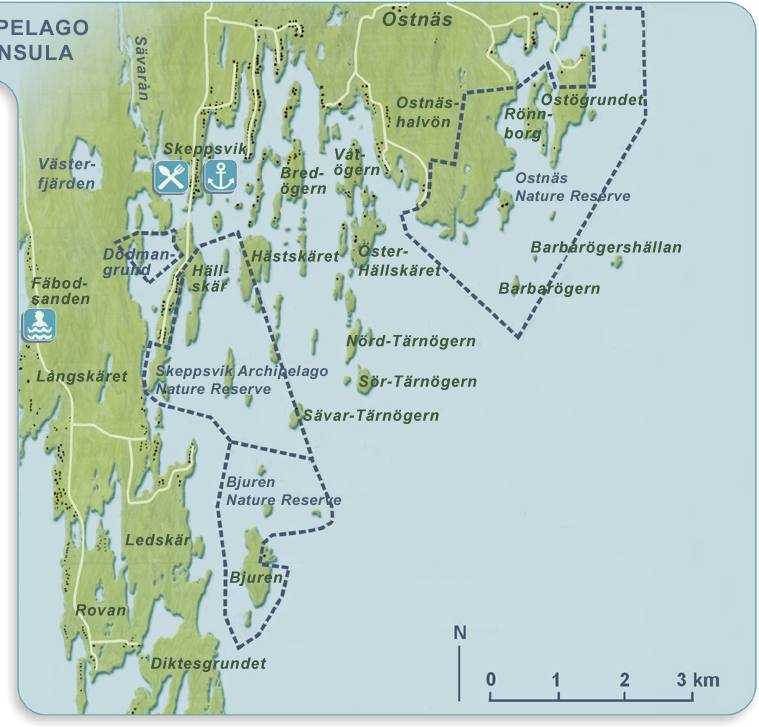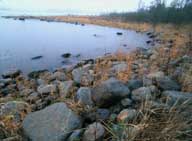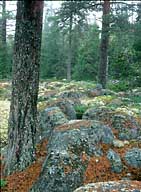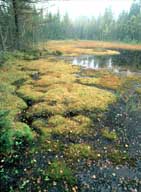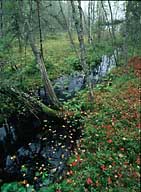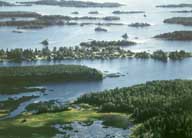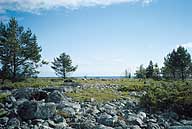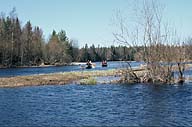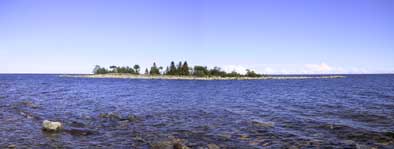Skeppsvik archipelago and Ostnäs
peninsula
Sweden's most impressive drumlin archipelago can be found
at Skeppsvik. Drumlins are elongated, low moraine ridges formed
by the most recent ice age. They can be seen outside the hamlet
of Skeppsvik in a clear north-south pattern - in the same direction
as the ice movement - and they are surrounded by the shallow sea.
Sometimes small end moraines (also called De Geer moraines), the
moraine type so common in the archipelago north of Björkö,
stretch across the drumlins. This fascinating geology of the coast
of Skeppsvik can be most clearly viewed from the air. The shallow,
rocky waters of the Skeppsvik archipelago are otherwise best experienced
in a kayak or on a pair of ice skates. The ice always arrives
early here. If you miss the short skating season, skis are also
a good way to view the archipelago. Start your excursion at Skeppsvik
manor house or at the end of the road a few kilometres to the
south, where a path leads a few hundred metres south to the farthest
tip of the Skeppsvik peninsula. From here there's a fantastic
overview of the southern end of the archipelago.
Bjuren is an isolated island farthest out in the archipelago.
Its ancient coniferous forest is almost untouched by man. Lovely
rock rubble fields and flat rock forests dominate the east side
of the island. A few kilometres south of Bjuren, Tavastudden sits
exposed to sea and wind. Getting there during the ice-free portion
of the year requires a five-kilometre hike on unmarked boulder-strewn
beaches. Your hike will be rewarded once out at the very tip,
where the sea meets heaven and heath. Its inaccessibility is no
disadvantage; usually you are undisturbed at Tavastudden, which
is more easily accessible in winter over the ice.
To the northeast of the Skeppsvik archipelago is Ostnäshalvön,
a forest-covered peninsula which was only recently declared a
nature reserve in the late 1990s. The reserve has many small bogs
and ponds where the shy red-throated diver usually breeds. The
red-throated diver population in Västerbotten is most dense
right here in the southern coastal area, where they often breed
in small, fishless ponds no more than a few kilometres from the
sea. The nest often sits on a small, isolated islet in middle
of the pond and the adult birds feed their young fish from the
sea.
Other bird species that you have a good chance of seeing
in the Skeppsvik archipelago are the osprey (Pandion
haliaetus), white-tailed eagle (Haliaetus
albicilla), little gull (Larus minutus),
redshank (Tringa totanus), turnstone
(Arenaria interpeak) and oystercatcher
(Haematopus ostralegus).
The Skeppsvik archipelago has many interesting plants:
| Alpine currant (Ribes alpinum) |
Ostögrundet |
One of Sweden's northernmost occurrences |
| Lesser burdock (Arctium minus) |
Hästskäret |
Northern Sweden's only remaining site |
| Hairy greenwind (Genista pilosa)
|
Vitögern |
Only known site in Northern Sweden |
| Nodding thistle (Carduus nutans) |
Skeppsvik dock area |
|
| Tall yellow sweetclover (Melilotus
altissimus) |
Skeppsviks dock area |
|
| Zigzag clover (Trifolium medium) |
Channel at Skeppsvik |
|
| Red Bartsia (Odontites litoralis) |
The point of the island by Skallvikögern |
The biggest stand in the county |
| Common marestail (Hippuris tetraphylla)
|
Sladan bay |
Probably gone now |
| Curled snow lichen (Cetraria
cucullata) |
Bjuren |
Usually found in the mountains and on Öland's
bare limestone soil. |
Like Bjuren and parts of the Ostnäs peninsula, the
western portions of the Skeppsvik archipelago are protected as
a nature reserve.
| 
